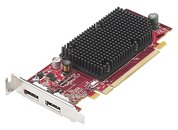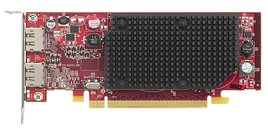Friday, March 14th 2008

ATI Launches New ATI FireMV 2260 Graphics Card
AMD today announced it is improving the visual experience for financial traders while simultaneously helping to reduce power consumption needs for some of the world's largest financial institutions. The new ATI FireMV 2260 2D workstation and desktop accelerator card enhances "trader density" in financial institutions, where IT managers seek to maximize productivity in every bit of workspace, overcrowded with people and hardware, while improving power consumption and cooling needs."Building on the innovative reputation of AMD among financial services customers, ATI FireMV graphics are quickly becoming the preferred solution for traders in some of the world's largest financial institutions," said Janet Matsuda, senior director, Professional Graphics, AMD. "With the introduction of the ATI FireMV 2260 graphics accelerator, AMD extends its technology and energy efficiency leadership. ATI FireMV 2260 enables financial institutions and corporations in general to reduce energy consumption, maximize today's workspace productivity and better plan for technology implementations in the future."
"Traders are dealing with ever-increasing amounts of financial and stock data that need to be accessed and analyzed in real-time, requiring multiple large displays to be crammed into tight desk spaces. The end result can often mean wasted space as well as increased heating and cooling requirements and associated costs," said Gene Peters, director of Information Services, Philadelphia Stock Exchange. "Financial institutions need graphics solutions that address density issues. The energy efficiency ATI FireMV 2260 graphics cards allows for more powerful and smaller systems, meaning we can fit more people and more systems in the same space, therefore maximizing 'trader density' and better managing heating and cooling costs."
Renowned financial institutions throughout the world are implementing ATI FireMV graphics accelerators in earnest. Three of the world's largest financial services organizations, two of which rank in the Top 50 of the 2007 Fortune 500, have recently standardized on the ATI FireMV series and are immediately realizing energy efficiencies, cost savings and the space economies these products can help deliver.
Investment Protection
The ATI FireMV graphics accelerator offers customers exceptional energy efficiency, while supporting new and emerging technologies like the Microsoft Windows Vista operating system. Notable features include:
The ATI FireMV 2260 2D workstation and desktop accelerator card is expected to begin shipping in April 2008 and will be available from workstation OEMs, system integrators and AMD channel partners worldwide. The MSRP is $249 USD. For more information about ATI FireMV products from AMD, please visit ati.amd.com/products/firemvseries/index.html.
Source:
AMD3
"Traders are dealing with ever-increasing amounts of financial and stock data that need to be accessed and analyzed in real-time, requiring multiple large displays to be crammed into tight desk spaces. The end result can often mean wasted space as well as increased heating and cooling requirements and associated costs," said Gene Peters, director of Information Services, Philadelphia Stock Exchange. "Financial institutions need graphics solutions that address density issues. The energy efficiency ATI FireMV 2260 graphics cards allows for more powerful and smaller systems, meaning we can fit more people and more systems in the same space, therefore maximizing 'trader density' and better managing heating and cooling costs."
Renowned financial institutions throughout the world are implementing ATI FireMV graphics accelerators in earnest. Three of the world's largest financial services organizations, two of which rank in the Top 50 of the 2007 Fortune 500, have recently standardized on the ATI FireMV series and are immediately realizing energy efficiencies, cost savings and the space economies these products can help deliver.
Investment Protection
The ATI FireMV graphics accelerator offers customers exceptional energy efficiency, while supporting new and emerging technologies like the Microsoft Windows Vista operating system. Notable features include:
- Ability to view 2D and 3D live video feeds: Traders using the ATI FireMV 2260 can receive up-to-date information from online news sources that provide live streaming video
- Certification and optimization for Microsoft Windows Vista and the Aero interface: The ATI FireMV accelerator incorporates 3D graphics into its design to ensure The Ultimate Visual Experience for Windows Vista.
- Passive Cooling for Improved Reliability: ATI FireMV 2260 features a passive heat sink, an innovative feature that dissipates heat from the GPU and eliminates the use of a cooling fan for quieter operation with fewer mechanical parts, making it the first "fan-less" dual DisplayPort (and therefore truly energy efficient) graphics card
- Approve one graphics card for use in your company's systems: the small form factor of the ATI FireMV 2260 enables IT departments to standardize on one card that can be installed in a broad range of x86-based systems, including workstations, desktop PCs and docking stations featuring AMD or other processors
- Two DisplayPorts: ATI FireMV 2260 is the first graphics card to offer two DisplayPorts, the latest standard that allows users to connect up to two large high resolution monitors with smaller and thinner cords.
- Assistance with long-term IT planning: The ATI FireMV 2260 supports emerging standards like PCI Express 2.0. The lower profile, half-length design of the ATI FireMV 2260 fits in practically any PCI, PCI Express 1.0 and PCI Express 16x slot for maximum flexibility.
- Product Warranty: Unlike typical consumer PC graphics cards that only offer a one-year lifecycle, the ATI FireMV card offers a three-year warranty for an extended product lifecycle.
The ATI FireMV 2260 2D workstation and desktop accelerator card is expected to begin shipping in April 2008 and will be available from workstation OEMs, system integrators and AMD channel partners worldwide. The MSRP is $249 USD. For more information about ATI FireMV products from AMD, please visit ati.amd.com/products/firemvseries/index.html.


12 Comments on ATI Launches New ATI FireMV 2260 Graphics Card
Unfortunately I can't seem to find any info as to which GPU it's based on... I'm guessing probably a modified X2400. Nice to see a half-height video card with 2x DisplayPort, 256 MB DDR2 and a passive heatsink - although I wonder how many of the world's largest financial institutions are using monitors with DisplayPort. :p
I concur.
The alternative (e.g. nvidia) is to have a proprietary connection and proprietary dongle to give 4 DVI outs. And, man, these are expensive. (I have one). Whereas the displayport solution is a "standard" and much cheaper to implement... and uses mass-market cheaper dongles.
EDIT
There is a PCI version of the card. Great! Easy add-in to existing computers... esp. to add extra displays. ati.amd.com/products/firemvseries/ATI_FireMV_2400_PCI.pdf
Notice that the PCI versions DOES NOT USE Displayport, but a proprietary connector. Oh well.
2./ workstation cards did dual DVI on both ports, whereas consumer cards dont
3./ firmware designed to optimise OpenGL rather than DirectX
4./ firmware designed to optimise vector drawing rather than texture maps
5./ additional features, like "3D glasses port"
6./ 4x output. Consumer cards can only drive 2 monitors, not 4
3 years ago, the feature set was VERY DIFFERENT, esp. points 3 and 4. However, modern consumer cards are now so powerful, that optimising for, e.g. CAD, is not really necessay since consumer cards can render drawings so fast. Made a big difference 3-5 yrs ago though.
The really interesting feature for today is 4x TFT out. I have a nVidia 280 that does this... but it really is lame on video streams or 3D. The newer cards can cope with this easy.
not much use to us lot.. exactly the opposite in fact.. he he
trog